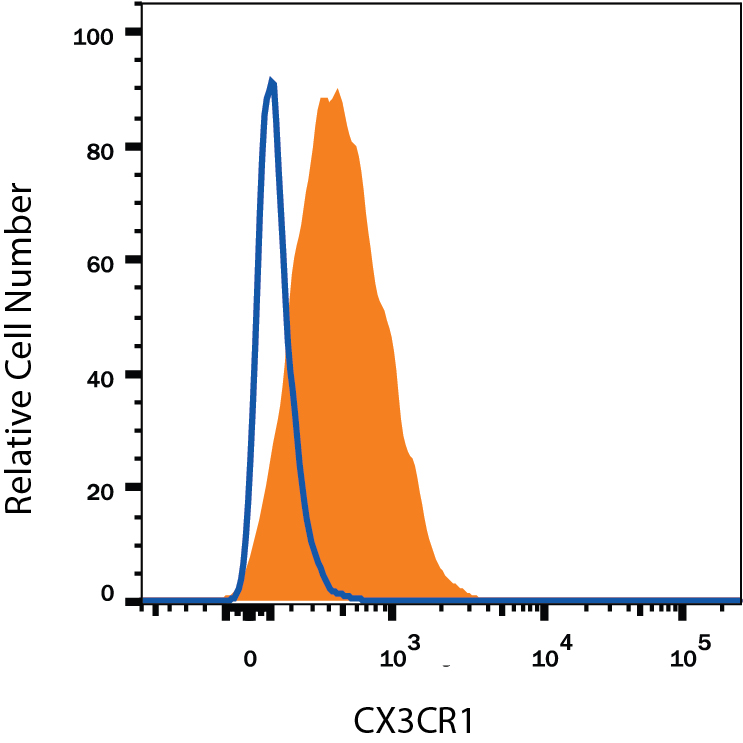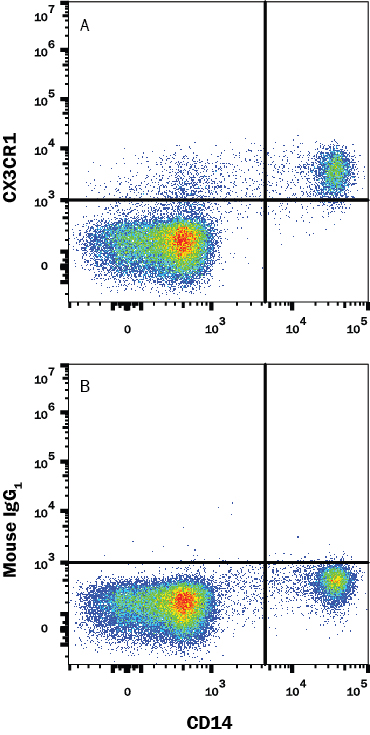Human CX3CR1 PE-conjugated Antibody Summary
Applications
Please Note: Optimal dilutions should be determined by each laboratory for each application. General Protocols are available in the Technical Information section on our website.
Scientific Data
 View Larger
View Larger
Detection of CX3CR1 in Human Blood Monocytes by Flow Cytometry. Human peripheral blood monocytes were stained with Mouse Anti-Human CX3CR1 PE-conjugated Monoclonal Antibody (Catalog # FAB5204P, filled histogram) or isotype control antibody (Catalog # IC002P, open histogram). View our protocol for Staining Membrane-associated Proteins.
 View Larger
View Larger
Detection of CX3CR1 in Human PBMC by Flow Cytometry. Human PBMC were stained with (A) Mouse Anti-Human CX3CR1 PE-conjugated Monoclonal Antibody (Catalog # FAB5204P) or (B) Mouse IgG1 isotype control antibody (Catalog # IC002P) and Mouse anti-Human CD14 APC-conjugated antibody (Catalog # FAB3832A). Staining was done at 37oC. View our protocol for Staining Membrane-associated Proteins.
Reconstitution Calculator
Preparation and Storage
- 12 months from date of receipt, 2 to 8 degreesC as supplied.
Background: CX3CR1
CX3CR1 is a 40 kDa seven transmembrane chemokine receptor that is expressed on several T cell subsets, monocytes, macrophages, microglia, and epithelial cells. CX3CR1 binding to membrane bound or soluble CX3CR1/Fractalkine promotes inflammatory responses by inducing monocyte adhesion to endothelial cells and macrophage activation. CX3CR1 polymorphisms are associated with the development of chronic inflammatory disorders. Alternately spliced isoforms have extended N-terminal extracellular regions that increase the potency of CX3CR1 as a fusion co-receptor for HIV-1. Human CX3CR1 shares 82% amino acid sequence identity with mouse and rat CX3CR1.
Product Datasheets
Citations for Human CX3CR1 PE-conjugated Antibody
R&D Systems personnel manually curate a database that contains references using R&D Systems products. The data collected includes not only links to publications in PubMed, but also provides information about sample types, species, and experimental conditions.
6
Citations: Showing 1 - 6
Filter your results:
Filter by:
-
Role of CCR3 in respiratory syncytial virus infection of airway epithelial cells.
Authors: Wellemans V, Benhassou H, Fuselier E, Bellesort F, Dury S, Lebargy F, Dormoy V, Fichel C, Naour R, Gounni A, Lamkhioued B
iScience, 2021-11-14;24(12):103433.
Species: Human
Sample Types: Whole Cells
Applications: Flow Cytometry -
Blood Monocyte Phenotype Fingerprint of Stable Coronary Artery Disease: A Cross-Sectional Substudy of SMARTool Clinical Trial
Authors: S Sbrana, J Campolo, A Clemente, L Bastiani, A Cecchettin, E Ceccherini, C Caselli, D Neglia, O Parodi, D Chiappino, JM Smit, AJ Scholte, G Pelosi, S Rocchiccio
Biomed Res Int, 2020-07-27;2020(0):8748934.
Species: Human
Sample Types: Whole Cells
Applications: Flow Cytometry -
Phenotypic changes of peripheral blood mononuclear cells upon corticosteroid treatment in idiopathic intermediate uveitis
Authors: Karoline Walscheid
Clin. Immunol, 2016-10-28;0(0):.
Species: Human
Sample Types: Whole Cells
Applications: Flow Cytometry -
CX3CL1/CX3CR1 and CCL2/CCR2 Chemokine/Chemokine Receptor Complex in Patients with AMD.
Authors: Falk M, Singh A, Faber C, Nissen M, Hviid T, Sorensen T
PLoS ONE, 2014-12-15;9(12):e112473.
Species: Human
Sample Types: Whole Cells
Applications: Flow Cytometry -
CD56(bright)perforin(low) noncytotoxic human NK cells are abundant in both healthy and neoplastic solid tissues and recirculate to secondary lymphoid organs via afferent lymph.
Authors: Carrega, Paolo, Bonaccorsi, Irene, Di Carlo, Emma, Morandi, Barbara, Paul, Petra, Rizzello, Valeria, Cipollone, Giuseppe, Navarra, Giuseppe, Mingari, Maria Cr, Moretta, Lorenzo, Ferlazzo, Guido
J Immunol, 2014-03-19;192(8):3805-15.
Species: Human
Sample Types: Whole Cells
Applications: Flow Cytometry -
Changes of peripheral TGF-beta1 depend on monocytes-derived macrophages in Huntington disease.
Authors: Di Pardo A, Alberti S, Maglione V, Amico E, Cortes E, Elifani F, Battaglia G, Busceti C, Nicoletti F, Vonsattel J, Squitieri F
Mol Brain, 2013-12-13;6(0):55.
Species: Human
Sample Types: Whole Cells
Applications: Flow Cytometry
FAQs
No product specific FAQs exist for this product, however you may
View all Antibody FAQsReviews for Human CX3CR1 PE-conjugated Antibody
There are currently no reviews for this product. Be the first to review Human CX3CR1 PE-conjugated Antibody and earn rewards!
Have you used Human CX3CR1 PE-conjugated Antibody?
Submit a review and receive an Amazon gift card.
$25/€18/£15/$25CAN/¥75 Yuan/¥2500 Yen for a review with an image
$10/€7/£6/$10 CAD/¥70 Yuan/¥1110 Yen for a review without an image





